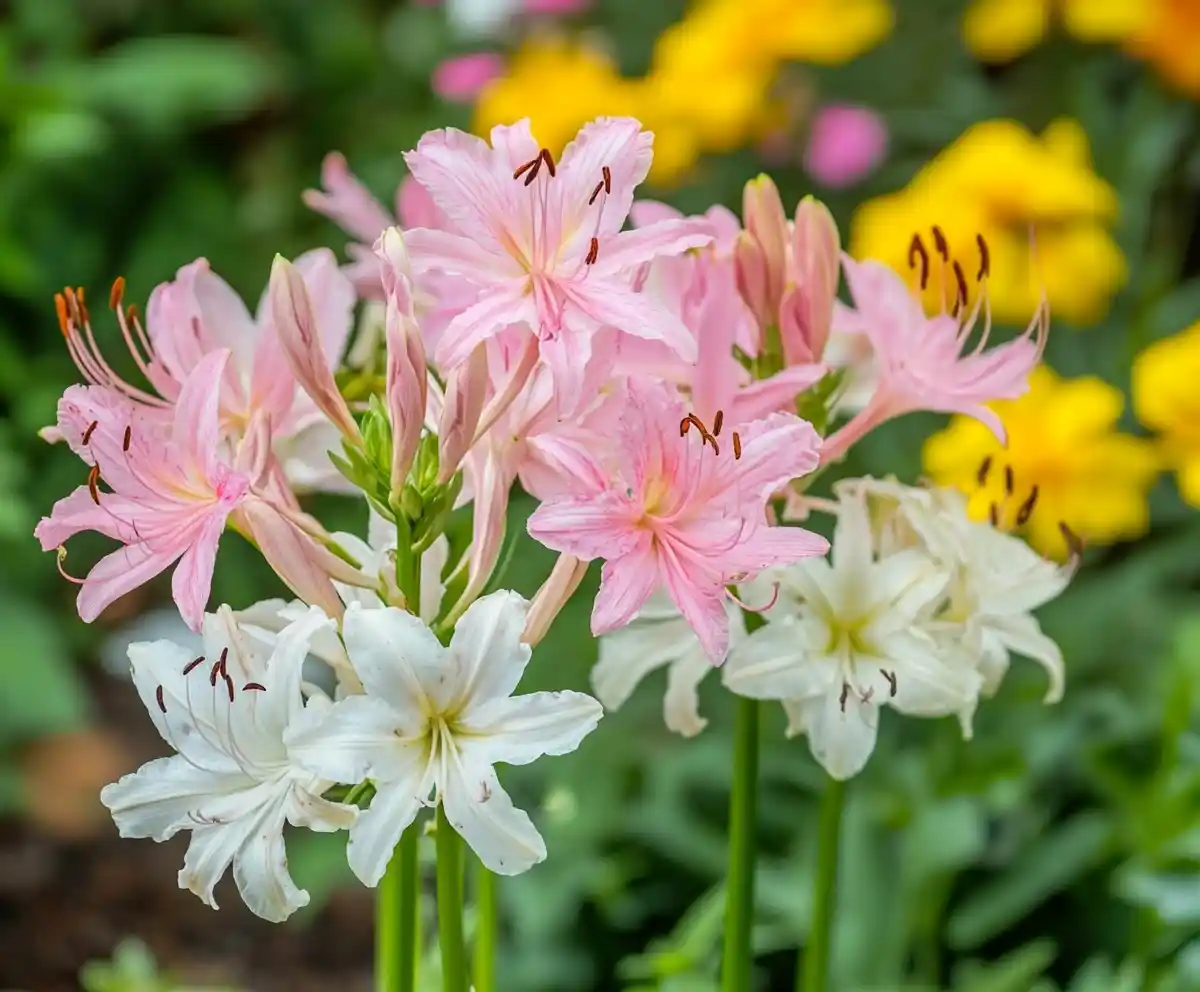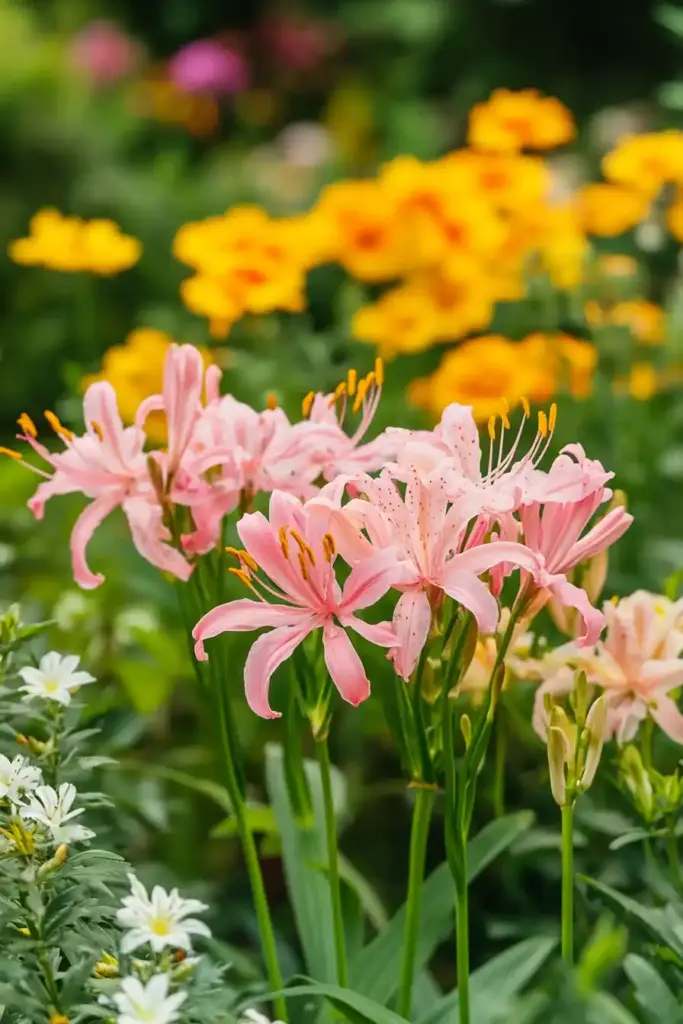Spider lilies (Lycoris spp.) are showstoppers in the garden, flaunting their spidery, ribbon-like petals in late summer and early fall. These bulbs, known for blooming on bare stems before any foliage appears, add surprise and elegance to borders, cottage gardens, and naturalized spaces. Originally native to Asia, spider lilies like Lycoris radiata have become naturalized across parts of the southeastern United States. Whether you call them naked ladies, hurricane lilies, or surprise lilies, these unique plants create unforgettable displays with minimal care.
⚠️ Important Note: All parts of the spider lily plant are toxic to humans and animals, so plant with caution around pets and children.
Table of Contents
🌿 Spider Lily Overview
Spider lilies belong to the Lycoris genus, a group of ornamental bulbs prized for their dazzling, late-season flowers and curious growth habits. While each species has its own charm, they all share a tendency to bloom on bare stems—earning them dramatic nicknames and admiration from seasoned gardeners.
Here’s a quick breakdown of what makes these bulbs so captivating:
| Feature | Description |
|---|---|
| Genus Name | Lycoris |
| Common Name | Spider Lily |
| Plant Type | Bulb |
| Light Needs | Partial Sun to Full Sun |
| Height | 1–3 feet |
| Width | 1–2 feet |
| Flower Colors | Red, White, Pink, Orange, Yellow |
| Foliage Color | Blue-Green |
| Season of Interest | Summer and Fall Blooms |
| Special Traits | Attracts Birds, Cut Flower Worthy, Deer Resistant |
| Hardiness Zones | USDA 5–10 |
| Propagation Method | Division |
With their tolerance for varied conditions and natural resistance to deer, spider lilies are a fantastic low-maintenance choice for adding seasonal flair to your landscape.
🏡 Where to Plant Spider Lily
Choosing the right spot for your spider lilies can make all the difference in their performance and longevity. These bulbs are relatively fuss-free, but they thrive best when given the right environment from the start.
Ideal Growing Conditions
- Sunlight: Spider lilies prefer partial sun but can also handle full sun in cooler climates. Too much shade may reduce blooming.
- Soil: Well-drained soil is essential. These bulbs can adapt to acidic, neutral, or alkaline soils (pH 6.0–8.0), as long as water doesn’t pool around them.
- Undisturbed Location: They bloom better after being left alone for a few years. Plant them where they won’t be dug up or divided frequently.
Best Garden Locations
Spider lilies shine in various landscape settings, including:
- 🌼 Cottage gardens
- 🌳 Naturalized woodlands
- 🌿 Borders and beds
- 🪴 Near patios or walkways
💡 Tip: Since the foliage goes dormant in summer, consider interplanting with a low-growing ground cover to maintain visual interest and disguise the empty space.
🌱 How and When to Plant Spider Lily
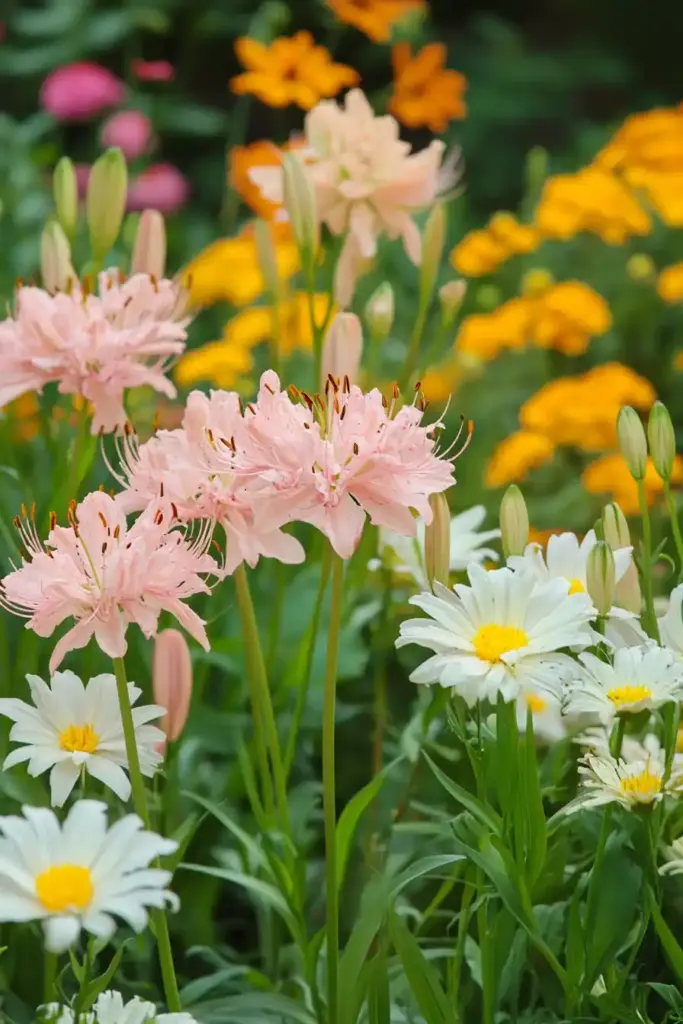
Planting spider lilies correctly sets the stage for years of effortless beauty. While they don’t demand much, timing and technique are key to helping these bulbs thrive and bloom reliably.
🗓 Best Planting Time
- Plant in early fall, when temperatures begin to cool but before the ground freezes.
- This gives the bulbs time to establish roots before winter dormancy.
🌿 Planting Depth and Spacing
- Depth: Position the bulb so that the neck is just below the soil surface, or ¼ inch exposed. Planting too deep may delay or prevent blooming.
- Spacing:
- Lycoris radiata: 6–12 inches apart
- Lycoris squamigera: 6 inches apart
💡 Tip: Space generously if you’re aiming for mass plantings—these bulbs multiply over time and can form impressive colonies when left undisturbed.
🌼 Spider Lily Care Tips
Once established, spider lilies are surprisingly low-maintenance. With just a bit of seasonal attention, they’ll reward you with spectacular late-summer blooms year after year.
☀️ Light
- Partial shade is often ideal, especially in warmer climates.
- They can handle full sun, but some afternoon shade can promote better flower quality and longevity.
🌱 Soil and Water
- Grow in well-drained soil to prevent root rot.
- Accepts a wide pH range: 6.0 to 8.0.
- Keep soil moist during active growth (spring to early summer).
- During dormancy in midsummer, let the soil dry out—avoid watering!
🌡 Temperature and Humidity
- Lycoris squamigera is the most cold-hardy (USDA Zone 5).
- Lycoris radiata needs winter protection in colder zones; plant in a sheltered location to protect evergreen foliage.
- Tolerant of high humidity and heat.
🌿 Fertilizer
- Early spring: Apply a high-nitrogen fertilizer to support foliage growth.
- Post-bloom (late summer/fall): Use a low-nitrogen, high-phosphorus fertilizer to nourish the bulbs and prepare them for dormancy.
✂️ Pruning
- Do not cut back healthy foliage. Leaves store energy for next year’s bloom.
- Remove only dead or diseased foliage in late winter.
🪴 Potting and Repotting Spider Lily
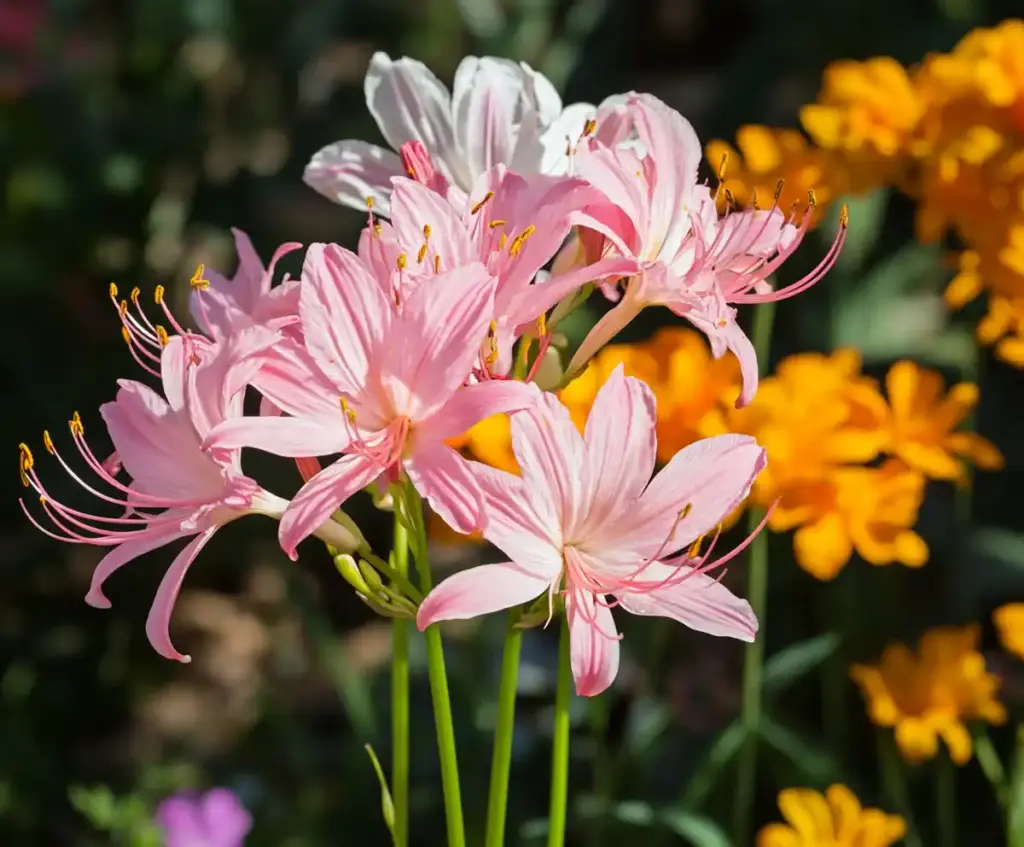
While spider lilies are incredibly rewarding in garden beds, they’re not well-suited for container growing. These bulbs develop deep, extensive root systems and don’t take kindly to disturbance—especially in climates with fluctuating temperatures.
Why Potting Isn’t Recommended
- Deep root systems need space to spread—most pots are too shallow.
- Temperature swings in containers (especially in Zones 5–7) can lead to bulb damage from freeze-thaw cycles.
- Container soil may retain too much moisture, increasing the risk of root rot.
If You Must Try Containers (Short-Term Only):
- Use very deep, well-draining pots.
- Bring indoors during cold winters if you’re in a marginal zone.
- Ensure soil stays dry during dormancy.
💡 Best practice? Keep spider lilies in the ground where they can naturalize undisturbed.
🐛 Pests and Problems
One of the many reasons gardeners love spider lilies is their resilience. These bulbs face very few pest or disease issues, making them a truly low-maintenance addition to your garden.
Common Issues
- Deer and Rodents: Typically leave spider lilies alone thanks to the plant’s natural toxicity.
- Root Rot: The main threat comes from waterlogged soils. Always plant in well-drained soil to avoid soggy conditions that can rot the bulbs.
Prevention Tips
- Avoid overwatering, especially during summer dormancy.
- Plant in raised beds or amend heavy clay soils with compost or sand to improve drainage.
- Inspect bulbs before planting to ensure they are healthy and firm, not mushy or moldy.
💡 Fun fact: Spider lilies’ toxicity acts as a natural deterrent to many common garden pests!
🌸 How to Propagate Spider Lily
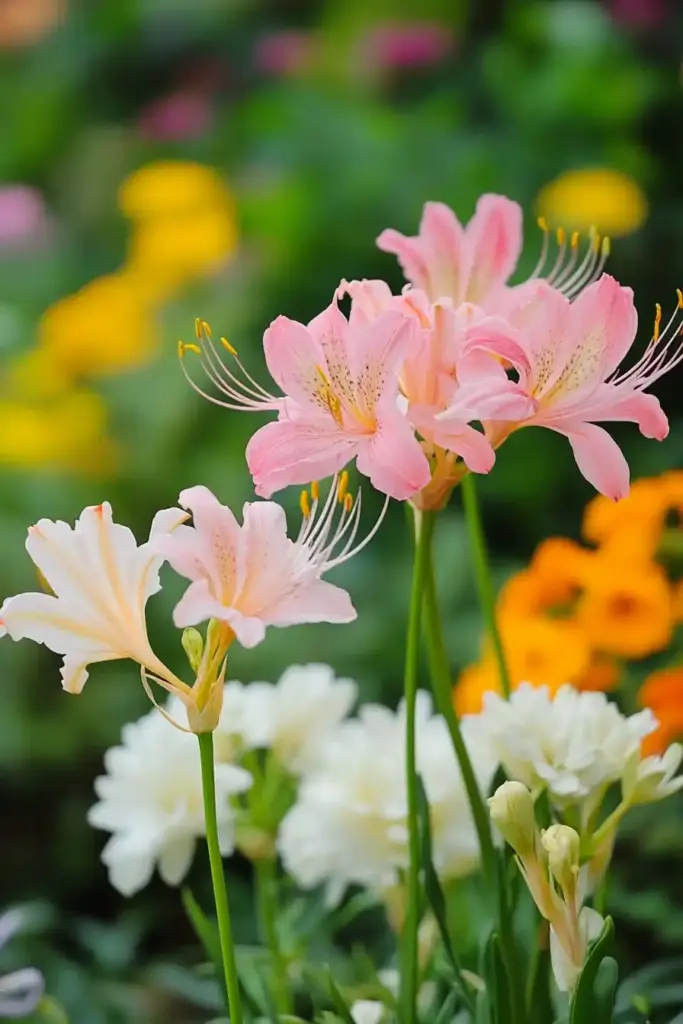
Spider lilies are easy to propagate, especially once established. Over time, they naturally form clumps of bulbs that can be divided and shared—or spread throughout your garden.
Best Time to Divide
- Early summer, just after the foliage dies back and the plant enters dormancy.
Steps to Propagate by Division
- Gently dig up the clump of bulbs using a garden fork or spade.
- Separate the offsets (smaller bulbs) from the main bulb.
- Replant bulbs at the same depth as originally planted, with necks just at or slightly above the soil surface.
- Water lightly to settle the soil, then allow the bulbs to rest until their natural growth cycle resumes.
💡 Tip: Division isn’t needed every year. These plants thrive when left undisturbed but benefit from thinning every 4–5 years to prevent overcrowding.
🌺 Types of Spider Lily
There are several beautiful species of spider lily, each offering its own flair in color, form, and hardiness. Whether you’re in a northern zone or a warm southern garden, there’s likely a Lycoris species perfect for your landscape.
🔴 Red Spider Lily (Lycoris radiata)
- Known for vivid red, spidery blooms.
- Grows up to 18 inches tall.
- Blooms in early fall.
- Best suited for USDA Zones 7–10.
- Often called the “hurricane lily” for its tendency to bloom during hurricane season.
⚪ White Spider Lily (Lycoris albiflora)
- Features elegantly curled white flowers.
- Reaches 18–24 inches in height.
- Ideal for Zones 8–10.
- Provides a crisp, luminous accent in evening gardens.
🌸 Naked Lady (Lycoris squamigera)
- Offers lilac-pink flowers on tall, bare stems.
- Foliage emerges in spring; flowers appear in late summer.
- Grows 18–24 inches tall.
- The most cold-hardy, thriving in Zones 5–10.
💡 Bonus: Hybrids and lesser-known species can provide additional color variations, including peach, yellow, coral, orange, and even pink with blue tips.
❓ Frequently Asked Questions About Spider Lilies
🌱 Do spider lilies spread on their own?
Yes! Spider lilies are excellent naturalizers. Over the years, they’ll form colonies by producing offset bulbs around the parent plant. This makes them a fantastic choice for low-maintenance gardeners who want to fill a space with long-lasting blooms.
🌸 Why do spider lilies bloom without leaves?
This unique habit is what gives spider lilies names like “naked lady” or “surprise lily.” The bulbs store energy from spring foliage, then bloom on bare stems in late summer or fall, creating a sudden splash of color when most plants are winding down.
🌈 Are there other flower colors besides red?
Absolutely. While red is the most common, spider lilies also come in white, pink, lilac, peach, yellow, coral, and bicolors, depending on the species or hybrid. This makes them versatile additions to colorful or themed garden designs.
🐾 Are spider lilies safe for pets?
No. All parts of the spider lily plant—especially the bulbs—are toxic to pets and humans if ingested. Plant with caution in areas accessible to dogs, cats, or small children.
🌟 Conclusion
Spider lilies are a remarkable blend of mystery and beauty, bringing unexpected charm to the late-season garden. Their spidery blooms and sudden appearance on leafless stems give them a mythical allure—yet they’re surprisingly easy to grow and care for. Whether you’re drawn to their vibrant colors, deer resistance, or naturalizing habit, spider lilies deserve a spot in any garden that values low-maintenance drama and long-lasting elegance.
Plant them once, give them space, and enjoy the magic they bring back year after year.

